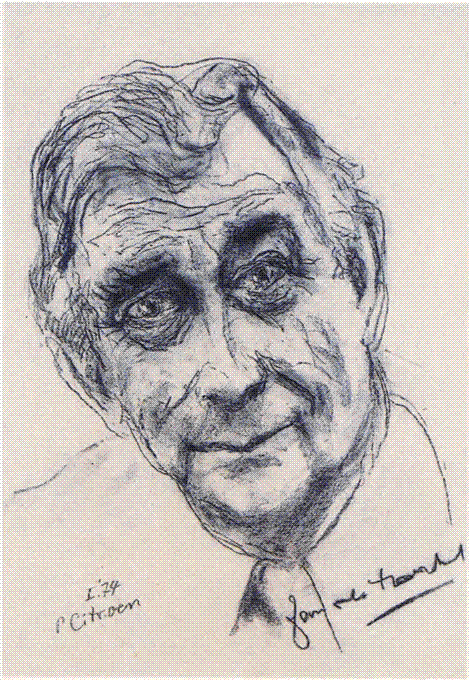literature. When 300,000 copies had been sold, De Hartog had to go into hiding because he refused to join the Kultuurkamer, the Nazi-led writers' guild. In 1943 he managed to escape from occupied Holland via France and Switzerland to Spain and freedom in England. The story of this dangerous journey went untold until 1999, when he published The Escape (De Vlucht), written with the help of his wife Marjorie.
Hollands Glorie is the story of Captain Jan Wandelaar and his ocean-going tug and how they transported the cranes, dredgers, hoppers, docks and sluice gates which the Dutch used to build harbours and dams all over the world, in Argentina and the Falklands, in the Middle East and the Dutch East Indies. The novel, written in a vigorous and salty, non-literary style, follows Jan Wandelaar's career from common sailor to captain of his own ship and his epic struggle with the arch-capitalist Kwel, who exploits and abuses the sailors who work for him. Like the socialist playwright Herman Heijermans in his play The Good Hope (Op hoop van zegen, 1900), De Hartog's novel paints a sharply critical portrait of the class divide in pre-war Dutch society, pitting honest Dutch sailors against the dirty tricks of the greedy company owners. In the end Wandelaar wins and takes over from Kwel, with the aim of protecting the interests of the sailors and especially of the Dutch tugboat industry against foreign competitors.
After the war De Hartog scored a second great bestseller with his trilogy God's Beggars (Gods geuzen). First published in 1947-49, it had been reprinted ten times by 1967, was translated into English in 1957 and made into a Hollywood movie, The Spiral Road, in 1962. It tells the story of young Dr Anton Zorgdrager and his heroic adventures in the Colonial Health Service of the Dutch East Indies (present-day Indonesia). Zorgdrager's first assignment is to fight a plague epidemic in Borneo, and around him De Hartog paints a whole world of colonial characters and episodes - the old Sultan playing billiards in his palace; Dr Brits-Jansen, the subject of many tall stories, an outspoken atheist and the world's greatest authority on leprosy; and the heroic Captain Willem Waterreus of the Salvation Army whose wife, once a prostitute in Amsterdam, is now a leper dying in Java. In the course of the novel Zorgdrager goes through a soul-wrenching, existentialist battle with religious doubt. Its climax is the gripping tale of tropical madness in the closing chapters, which was separately published as ‘Duel with a Witch Doctor’ in Reader's Digest Condensed Books in 1961. Set on the wild coast of New Guinea, it recounts the spiritual battle between young Zorgdrager and the Papuan witch doctor Burubi whose black magic slowly drives Zorgdrager insane, causing him to run off into the jungle and degenerate into a naked apeman, until he is, finally, saved by the white magic, the true religion, of his friend the Salvation Army Captain.
Despite these two great successes, or perhaps because of them, De Hartog - whose model had been the American novelist and social critic Upton Sinclair (1878-1968) - was seen as ‘just’ a popular storyteller. His novels received little critical acclaim in the Netherlands, not least because his heroic romanticism and passionate religious concerns were perceived as simplistic in the prevailing intellectual climate of post-war Holland. In retaliation, in 1950 De Hartog, defending his own craftsmanship and ‘unrelenting, shameless honesty’, launched a scathing attack on what he called the pathological degeneration of the Dutch highbrows of the day - writers like Simon Vestdijk, Anna Blaman and W.F. Hermans, no less - whom he described as a bunch of ‘psychopaths, spotty adolescents, lesbian women....and bloated masturbators.’
After this clash De Hartog left the Netherlands and - like other Dutch authors such as Dola de Jong, Leo Vroman and Hans Koning - settled in the United States. He decided to write in English, and from the start this was a great success. In 1951 his play The Fourposter - about his love affair with Dutch actress Lily Bouwmeester - was turned into a musical, I Do, I Do, and became a hit on Broadway, where in 1952 it was chosen as best play of the New York season. That same year The Fourposter was made into a movie, and in Minneapolis I Do, I Do began a successful run of 22 years. Another of his plays, Skipper next to God, was also made into a film, The Inspector (1961); in it, after the war, a Dutch policeman rescues a Jewish girl from an ex-Nazi and helps to smuggle her to Palestine.

Jan de Hartog (1914-2002), as portrayed by Paul Citroen in 1974. Collection Letterkundig Museum, The Hague / © sabam Belgium 2003.